What are the most common plain bearings made of?
Shery George | 30 January 2024
Plain bearings stand out from ball or rolling bearings due to their less complicated design. But is this simplicity always true? The reality is, that various types of plain bearings have distinct constructions and workings. In this blog, we’ll explore the structure of the most common plain bearings.
Overview of plain bearings and how they work.
Plain bearings are designed based on a simple principle. When parts move, their surfaces rub or slide on the plain bearing. To reduce friction, different methods are used, such as applying soft plastic coatings for smooth sliding or adding lubricating grease. These approaches have varying demands on the bearing’s structure, resulting in different types of plain bearings.
Solid plain Bearings with Lubrication Grooves
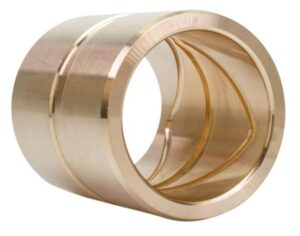
Solid plain bearings are sturdy and made of a solid material like steel, bronze, or other metals. These bearings have lubrication channels or grooves on their surface, allowing grease to distribute effectively. However, this also means that the bearing must be permanently lubricated. While they can handle large loads, their complex processing and solid material make them relatively expensive.
Sintered bearings
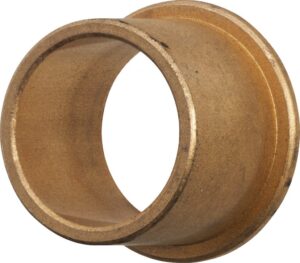
Sintered bearings get their name from how they’re made. They’re typically made from bronze powder, compressed at high pressure and temperatures in a process called sintering. This creates pores in the bearing due to the grain size of the powder. These pores serve a similar purpose to lubrication channels in solid bearings. The sintered bearings are soaked in oil, settling into the pores. During operation, the frictional heat heats the oil, reducing its viscosity, making it more fluid and releasing it from the pores, thereby lubricating the bearing position. Sintered bearings are relatively cost-effective and can also be manufactured in thicker wall thicknesses. They are well-suited for positions with higher rotational speeds and less suitable for slow swivel movements.
Metal composite bearings
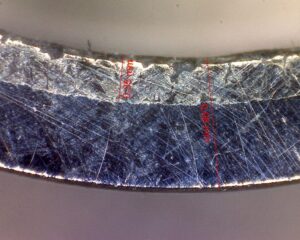
Metal composite bearings are made by combining different materials with distinct specifications. Typically, they involve a metal sheet that is shaped by rolling. The sheet metal is then coated with a plastic layer optimized for sliding, providing the required sliding properties internally. Sliding materials like PTFE or POM are commonly used. PTFE, known for its excellent sliding properties, allows the bushings with PTFE coating to function without needing additional lubrication with grease or oil. However, a drawback is that PTFE is soft and slides so well that it’s challenging to fix and prone to mechanical stress. To address these issues, the soft material is rolled onto specially treated sheets before being shaped into bushings. To ensure PTFE adherence to the sheet post-rolling, a layer of porous bronze is often sintered on in advance.
Metal composite bearings are cost-effective, suitable for various applications, and, depending on the design, may not require extra lubrication. However, there’s a risk of corrosion in humid environments, and the extremely thin sliding layer is relatively sensitive to mechanical stress.
Composite plain bearings
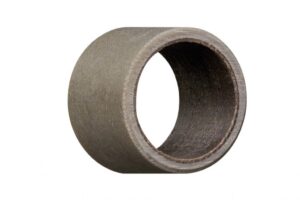
Composite plain bearings combine different materials, often referred to as plain bearings made of fiber composites. In simple terms, materials like mineral fibers (glass, carbon), natural fibers (cotton), or plastic fibers are woven together with synthetic resins and other additives. These are then pressed under high temperatures and pressure. The outcome is robust, high-strength bearings that can rival the strength of metallic bearings, depending on the type of load. Various winding and weaving techniques can be employed to create different layers with different specifications. Typically, a sturdy fabric serves as the outer shell, while an inner layer, optimized for sliding properties, reduces friction in the bearing.
These composite plain bearings are commonly used in large equipment like agricultural, construction, and mining machinery due to their ability to support very high loads. Depending on the design, some may need additional lubrication, but many variants are suitable for dry operation. While they can be more expensive in larger dimensions compared to solid metal bushings, they offer corrosion-free and optionally lubrication-free properties.
Plain bearings made of solid plastic
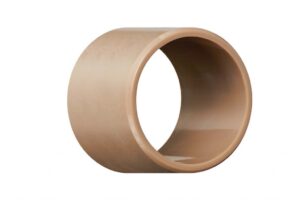
Plain bearings made of solid plastic, also known as polymer plain bearings, are crafted from plastic materials. Common manufacturing methods include injection molding, bar stock components, 3D printing, or laser sintering. Numerous plastics are suitable for these bearings, each with specific properties like high chemical resistance or resistance to temperatures up to around 300°C. These plastics, available in pellet form before processing, can be easily mixed with other ingredients like fibers, fillers, and additives. This blend is fused during processing, creating components with enhanced specifications compared to the original plastics. This production method results in very sturdy and exceptionally smooth plain bearings.
The advantage of these bearings lies in their uniform structure where the robust support material and sliding material are distributed throughout the component rather than being in separate layers. Additionally, the cost-effective manufacturing process is suitable for producing large quantities. Most plastic plain bearings also don’t require additional lubrication, which makes them self-lubricating bearings.
